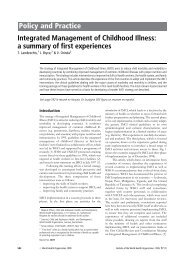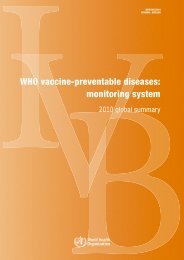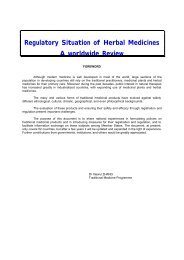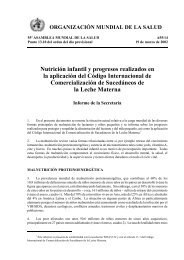IPDE - Extranet Systems - World Health Organization
IPDE - Extranet Systems - World Health Organization
IPDE - Extranet Systems - World Health Organization
Create successful ePaper yourself
Turn your PDF publications into a flip-book with our unique Google optimized e-Paper software.
Problems in the field of<br />
personality disorders<br />
Alv A. Dahl and Antonio Andreoli<br />
When the <strong>World</strong> <strong>Health</strong> <strong>Organization</strong>AJS Alcohol, Drug Abuse and<br />
Mental <strong>Health</strong> Administration (WHOIADAMHA) decided to conduct<br />
the International Pilot Study of Personality Disorders (IPSPD), they<br />
entered one of the most controversial fields of mental disorders. Many<br />
psychiatrists have doubted the validity of personality disorders (PDs)<br />
and their diagnostic reliability has been found to be very low. Theories<br />
of their etiology have implicated constitution, genes, brain abnormalities,<br />
bad morals, poor environment, and disturbed psychological development.<br />
There are no generally accepted treatments for PDs, and their<br />
long-term outcome is often unknown. Since the introduction of DSM-I11<br />
in 1980, however, empirical studies of PDs have flourished. The research<br />
has brought into focus many of the problems related to PDs. This chapter<br />
will describe some of them, and try to place the IPSPD and <strong>IPDE</strong><br />
(International Personality Disorder Examination) within that context.<br />
Basic descriptions of personality<br />
Throughout history attempts have been made to identify the basic dimensions<br />
or categories that best define the essential similarities and differences<br />
among people. Hippocrates identified four basic temperaments based on<br />
the balance of the body fluids. The phrenologists stated that they were able<br />
to identify personality characteristics through the contour variations of the<br />
skull. Kretschmer and Sheldon described personality feanxes based on<br />
physique, and believed that these personality types predisposed to the<br />
major mental disorders. In 1908 Heyman and Wiersma statistically analyzed<br />
the personality traits of a great number of ordinary people, and they<br />
found that personality could be described by three orihogonal factors. The<br />
study of basic personality dimensions was later promoted by Eysenck who<br />
identified three dimensions called neuroticism, extraversion, and psychoticism.<br />
Personality psychologists later expanded these to five dimensions<br />
('the big five'), adding conscientiousness and agreeableness.'

















